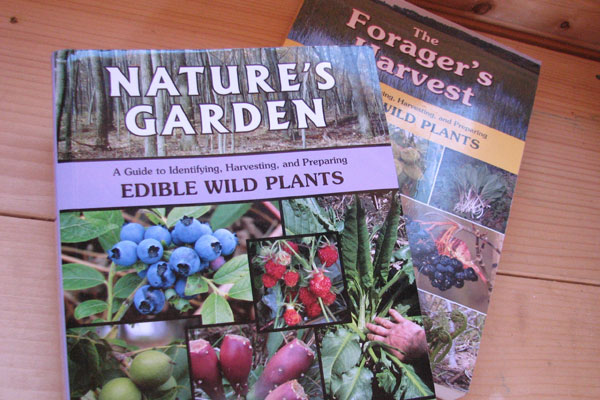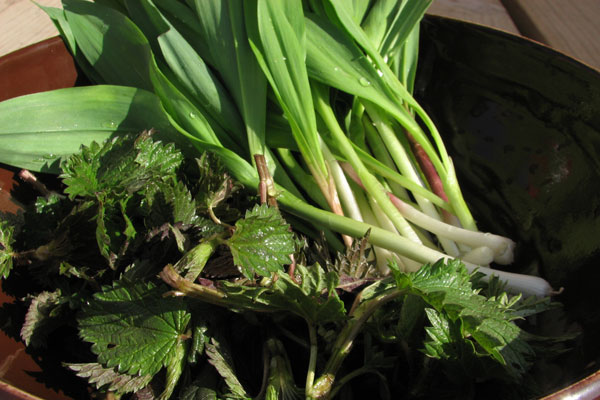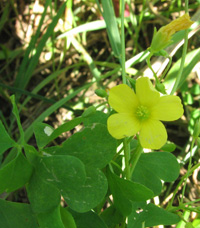
Foraging for wild foods is a hot topic among the food-obsessed these days, the natural progression, perhaps, in a line that runs from farmers markets to CSA shares to backyard gardening and urban chicken coops. For some people, the quest for an unmediated, authentic food experience won’t be complete until they walk into the forest empty-handed, and come out with dinner.
But heading out into the woods to forage for one’s supper can be a daunting prospect for the uninitiated. It helps to have a guide.
Short of having a personal foraging mentor, wild foods enthusiasts in the upper Midwest could hardly have a better guide than the work of Sam Thayer, author of The Forager’s Harvest (2006) and Nature’s Garden (published this past spring). Taken together, these books represent a remarkable and ongoing project of explicating, extolling, demystifying, and generally evangelizing on behalf of wild foods. According to a press release for Nature’s Garden, “The only way to save nature is to eat it.”
Thayer lives, writes, and forages in northwestern Wisconsin, and wild foods are a daily part of his diet. They’re a frequent component of mine, as well. I’ve been gathering wild foods for over 20 years, and I’ve written frequently about the topic in my blog, Trout Caviar. Reading Sam Thayer, though, I feel like a Cub Scout on his first camp-o-ree, agog and a bit at sea in a world I never knew was so big, or so varied.

Where a typical field guide imparts factual information and little else, Thayer’s books place wild foods in a much broader context. He is compulsive about getting it right, even critiquing in passing various other books on wild foods that don’t. He debunks a lot of wild foods bunkum, like the widely disseminated misinformation that milkweed is bitter. Considering whether the edible underground portion of the spring beauty is a tuber or a corm, he settles the question almost Solomonically, judging that it is neither: It is root.
While taxonomy of the claytonia root may at first glance appear hopelessly, boringly esoteric, wouldn’t you want to know that the person who is telling you which wild plants are delicious and which could really harm you approaches the topic with all possible seriousness?
One result of this thoroughness is that he must sacrifice breadth for depth, taking up a relatively small number of wild plants in each book. You won’t find every edible plant in the country, or even in the region, listed in either book. Some fairly common edible wild plants, such as watercress and purslane, are absent from both. And both completely avoid the topic of wild mushrooms, which is a pity; I hope Thayer has a guide to wild mushrooms of the Upper Midwest in his plans.

In both books, the botanical and practical descriptions are scrupulous. The photographs are superb, and unlike the typical field guide which might illustrate, say, one group of leaves and one bunch of fruit, Thayer’s photographs display a plant from many angles, in different seasons, and often in its natural variations. Just as important are the photos of other plants, whether toxic or not, for which a given plant might be mistaken.
No single guidebook could be thorough enough to turn a total beginner into a latter-day Euell Gibbons overnight. But anyone with a little woods knowledge, a bit of familiarity with plants, can use these books with utter confidence.
Last fall I was flipping through The Forager’s Harvest one morning and spent a few minutes reading about highbush cranberries, which I had heard were common in this area, but which I had never noticed. The careful description begins evocatively, with an anecdote about snacking on these bright, tart berries while on a long deer stalk on a cold fall morning.
That same afternoon, on a hike in a boggy woods, I stopped to examine a shrubby tree dangling ruby-red fruit. I recognized it immediately as highbush cranberry. The photos in Thayer’s book might have been taken of this exact tree. I tasted one, tentatively, and immediately noticed the tart, pleasant, cranberry-like flavor. I gathered some fruit and a few of the leaves, and once back home I confirmed my ID. I flavored a cocktail with highbush cranberry puree, and toasted becoming acquainted with an excellent new wild edible, thanks to Sam Thayer.

Both books follow the same format in the “field guide” sections: Each plant is introduced with a brief anecdote (Thayer’s writing shows great progress in these more “literary” sections from the first book to the second), followed by a description, discussion of range and habitat, then harvest and preparation. Regarding this last, Thayer is at pains to point out in the introduction to Nature’s Garden that this is not a cookbook: “Some people feel that all wild food books must be cookbooks. This baffles me, since nobody feels that way about gardening books.”

There’s a bit of a distinction here, though, since there exist in all likelihood literally millions of cookbooks that deal with domestic produce, and many, many fewer that take up preparing wild foods. While a purist like Thayer may be content to consume a wide range of wild plants “boiled, with salt,” a future project might be to team with a capable cook to develop ways to make the most of these wild plants in the kitchen. (In the meantime, author Teresa Marrone’s Abundantly Wild has a lot of good recipes using many of the foods covered in Thayer’s books.)
Both of Thayer’s books include extensive introductory material, with essays on getting started with wild food, identification and safe consumption, storing, processing, and timing the wild harvest. In addition to the more practical information, Thayer also lays out his philosophy of wild food in these early pages, and talks about the role of wild food in human history. He argues convincingly that there is no dichotomy between “wild” and “domestic” food plants, but that they exist, instead, on a continuum. In some instances, indeed, there is literally no difference between wild and domestic, except how the plant was sown: “Wild” asparagus, parsnips, and carrots, as well as many kinds of berries, are botanically identical to the farmed crops of the same names.
One of the high points of Nature’s Garden is Thayer’s account of “One Month Eating Wild,” which displays at once his humor, his somewhat querulous manner, his knowledge, and his insight. Answering those who question whether modern conveniences like electricity, toothpaste, and even toilet paper were “allowed” during the month of eating wild, Thayer writes, “I am not Paleolithic, by the way. Unlike many Paleolithic children, I grew up watching MacGyver and playing Atari. Why would I need to prove that people can live with Stone-Age technology? That was proven in the Stone Age.”
There are times when Thayer’s zeal to promote the products of nature’s garden leads him somewhat astray. In The Forager’s Harvest he spends nearly five pages singing the praises of the marsh marigold, only to lead us to this shaggy dog ending in the next-to-last paragraph:
“The problem with marsh marigold greens, however, is that they inherently taste bad. The more one boils them to leach the acrid principle out, they less bad they taste, but they never become truly good.”
And in Nature’s Garden, a diatribe about the flaws of Into the Wild, both book and movie, which Thayer uses to illustrate the (erroneous, in his view) “poisonous plant fable,” goes on for far too long.

So some things about these books left me scratching my head; and yet, if one were stuck in the woods and very hungry, wouldn’t you want to know that a mess of marsh marigolds, even though they cook up into a “mushy-textured green pudding,” could provide some needed nutrition? From that rambling critique of Into the Wild, I was fascinated to learn just how much wild food is required to survive, given the generally low fat and carbohydrate content of wild plants and meat alike. Even in his less brilliant moments, Thayer is still thought-provoking.
Provoking might be what Sam Thayer mainly intends to be. He wants to provoke us into seeing that Great Nature may be the best farmer around, and that her products are the most flavorful, healthful, eco-friendly, and enlightening foods we can eat. Converting to a diet of stinging nettles, acorns, and chokeberries might not save your life, your soul, or the world, straightaway, but Thayer believes that it’s a good place to start. With a biologist’s eye for detail, a poet’s lyricism about wild food plants and the places we find them, and an evangelist’s fervor for leading us out of the supermarket aisles and into the forest, Thayer presents a compelling case for redefining the whole notion of “going out to eat.”
Brett Laidlaw’s forthcoming cookbook, based on his Trout Caviar blog, focuses on year-round, local, and sustainable food gathering, cooking, and eating. Available fall 2011 from Borealis Books.

Comments are closed.